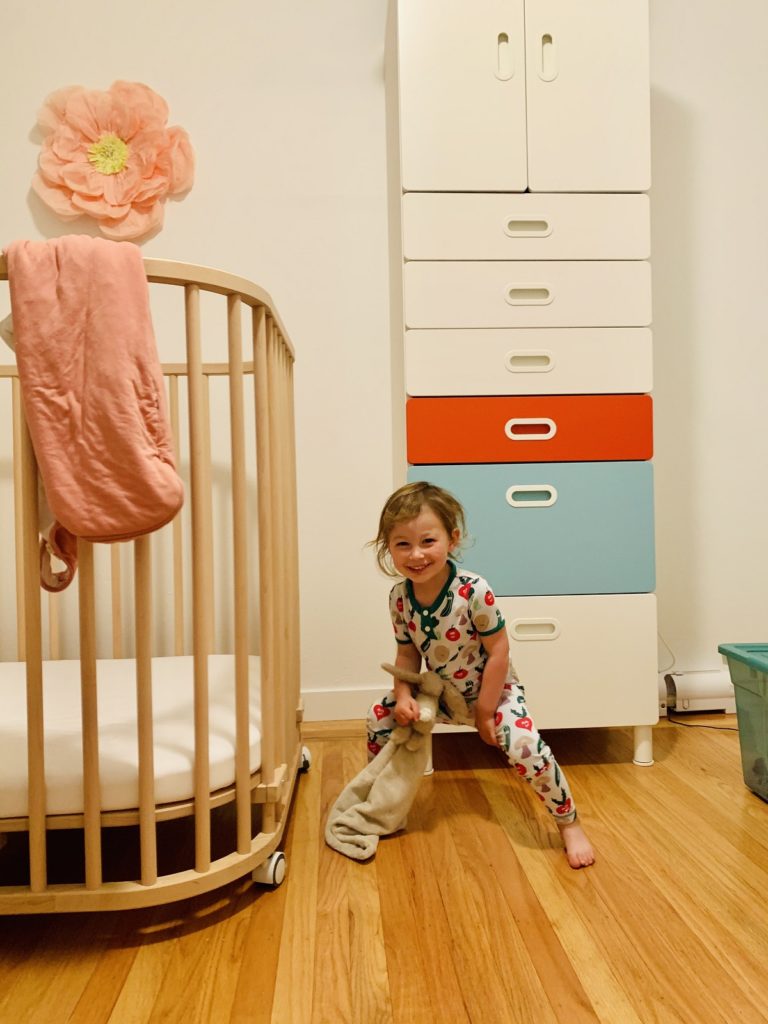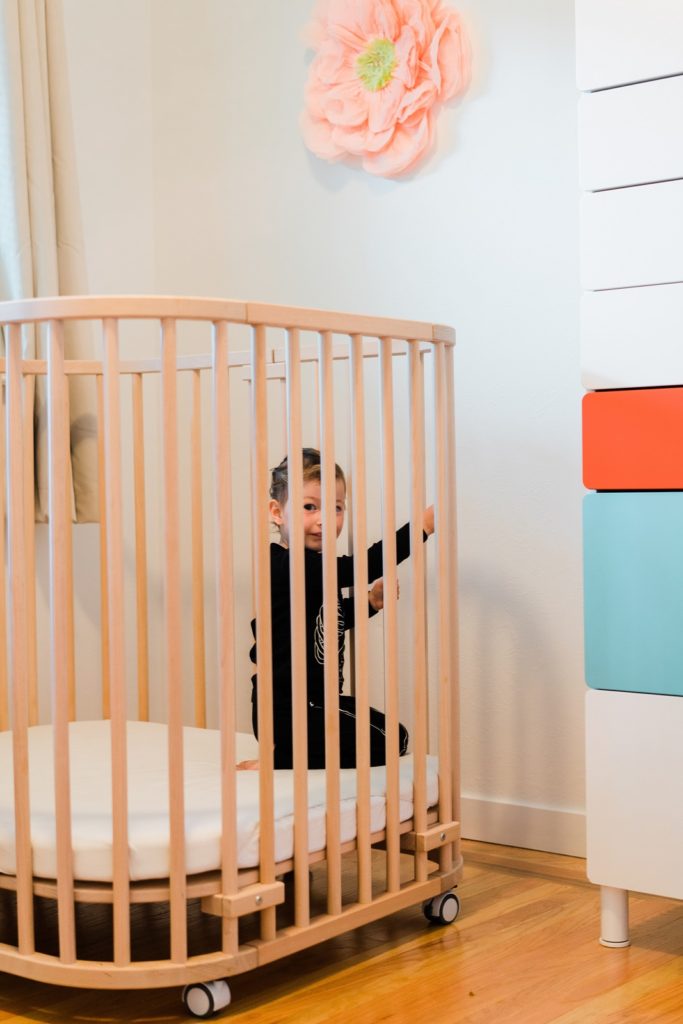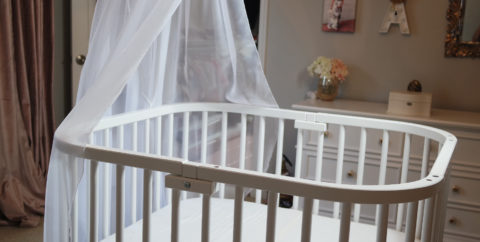time to stop co-sleeping
No matter how long you’ve been co-sleeping — or the reasons that brought you to the long-done sleep practice in the first place — there will come a time when you know it’s time to stop co-sleeping.
Maybe your little one has grown out of their bedside sleeper. Or maybe you’re starting to sense that everyone in the family (your little one included!) would get better rest if they were in a crib or room of their own.
Let’s get this out of the way from the get-go: no matter the “why” behind the timing, only you know when it’s the right time to stop co-sleeping.
Luckily, transitioning your little one away from this sleep practice doesn’t need to be a struggle. And it doesn’t need to be a “take months until you’re all desperate for sleep” kind of thing.
With a few gentle tips and pre-transition tricks, you’ll be able to easily nurture your baby into rest in their new crib or room. Without having to feel stressed out while doing it.
Know Your Where and Why
If you’re feeling like you need to do all the research, get the whole process down, and be fully “in the know” when it comes to easing the transition from co-sleeping before finally giving it a go: we get it.
It can be easy to over-invest in the “how-tos” behind a milestone like this. Or worry about whether getting it wrong will lead to mornings of bleary eyes for you and hard nights of tears for your little one.
But here’s the real secret behind making the transition from co-sleeping easier: give up on the over-Googling, and get in tune with your where and why.
Instead of trying to learn every little thing there is to know about how to stop co-sleeping as a first step in the process, prepare for this next important milestone by taking stock of where your baby is in their developmental journey. As well as why your family believes that transitioning from co-sleeping is the right next step for you.
Your where and why are valuable guides that will help you determine the best and smoothest transition strategy for you and your family.
So that you can make things easy from the first night. Instead of dealing with months of exhaustion and frustration as you try out whatever method a well-meaning relative or friend told you is “right.” (With little to no success, we might add.)
How to Stop Co-sleeping: What to Know About Your “Where”
If you’ve been co-sleeping with your baby through the first months of their life (as many parents do with the help of a bedside sleeper), then you’ll likely find that your baby’s developmental milestones are what’s driving you to switch up your sleep practice. 
For some families, the time to stop co-sleeping comes when their baby becomes mobile enough to easily crawl, roll, or scoot out of the safety of their made-just-for-them sleep space and into the plusher bedding of their parent’s bed.
Safe co-sleeping tools like bedside co-sleepers are designed to nurture your baby in the protective and supported embrace of a made-just-for-them mattress. On the flip side, the plush bedding that adults prefer — which can include things like mattress pads, thick blankets, and layers of snuggly warmth — can easily wrap around your baby or leave their body unsupported through the night.
If you’re transitioning away from co-sleeping because your baby is starting to enter the exciting time in their life when they’re learning to roll and crawl, then you may be simply looking to move your baby away from your bed but not fully out of your room.
The “where” of where you want your baby’s final sleep destination to be can help you decide what transition strategy will work best to try.
If they’re simply moving to a crib on the other side of your room, then you might find it easier to go “all-in” with getting your little one used to their new sleep set-up. While moving them to a nursery down the hall might mean introducing a little extra prep work into your pre-transition strategy.
What to Do with Your Where: Easing the Transition from Co-Sleeping
If you’re simply moving your baby further away from your bed (but keeping them in your room with you):
Start by pushing your little one’s new baby bassinet or crib against your bed. Instead of keeping them side-by-side with you through the night, let them learn to rest for a few nights in their new sleep space: while you still remain within easy reach.
As your baby becomes increasingly comfortable in their new set-up, move your baby’s crib father and farther across the room.
By doing this process slowly, you’ll give your baby the time they need to gain confidence that having you out of reach doesn’t mean that they aren’t being looked after and loved all night long. 
Keep this gentle distancing strategy going until your baby has gained a full sense of peace with their new way of sleeping.
If you’re planning to move your baby to a nursery:
If you’re moving your little one to a nursery down the hall — or are closing out your co-sleeping journey when they’re a little older in age — then you might find it helpful to do even more pre-work to prepare your little one for the transition.
Help your get on a consistent sleep routine, with pre-bedtime rituals that leave them feeling perfectly rested but not over-tired.
If they’re a little older in age, you might also start with books or pre-bedtime chats that help them see the many exciting things they can expect now that they’ve hit this new milestone in their co-sleeping journey (a room of their own! a new crib! oh my!).
By getting consistent with a pre-bedtime routine, you’ll set your little one up to be comfy and relaxed as they sail toward bedtime.
Meanwhile, stirring up excitement for your little one’s new sleeping adventure in advance can help them understand that moving into a room of their own is a natural (and much-awaited!) next step as they grow big and strong.
How to Stop Co-sleeping: Know Your Why
There are many reasons why parents might decide that now is the time to stop co-sleeping.
Whether you’re looking for a little more privacy during the night. Are worried that your child has outgrown your current co-sleeping set-up. Or just feel like the time is “right”: knowing the reasoning behind your decision will help you choose a method for stopping co-sleeping that works perfectly for your family.
Going “Cold Turkey”
Parents looking for a little more privacy might be more inclined to try the “cold turkey” method, where one night your bedroom simply becomes “off the table” as a sleeping option. 
We won’t sugarcoat it: going “cold turkey” might leave you rocking and rolling through some resistance the first few nights.
However, being firm and consistent in your decision to stop co-sleeping will help your baby learn that their new room is a safe and secure space to sleep (even if you aren’t always right by their side).
The Slow and Steady Approach
On the other hand, parents who have been prepping for a transition away from co-sleeping for a while now might find that a slower and more methodical approach (like slowly moving your baby’s crib or baby more and more distanced from your own) leads to quieter and less stressful nights of rest for all.
(This is especially true for parents who have been watching their baby hit come closer to developmental milestones for a while, with full understanding that they’re making their way toward independence quickly.)
If you’re not in a rush to quit co-sleeping, then coming up with a game plan —by outlining how and when you’ll slowly transition baby away from co-sleeping — can help make the process a smooth one.
Plan out small changes you can make each night that will ultimately build to baby’s full sleeping independence.
This might mean deciding how far you’ll move their crib from your bed every night, or coming up with a plan to sleep on a mattress beside your baby’s crib for a few nights before leaving them to try out their new space fully on their own.
The Most Important Thing to Remember
No matter when you make the transition, know one thing: how to stop co-sleeping depends on the needs of your baby and family.
So rather than looking for the “right” method, simply continue to ask yourself: is this plan right for us?
Keeping that question at the top of your mind will make sure that this next step in your co-sleeping journey is a smooth and exciting time for all.
